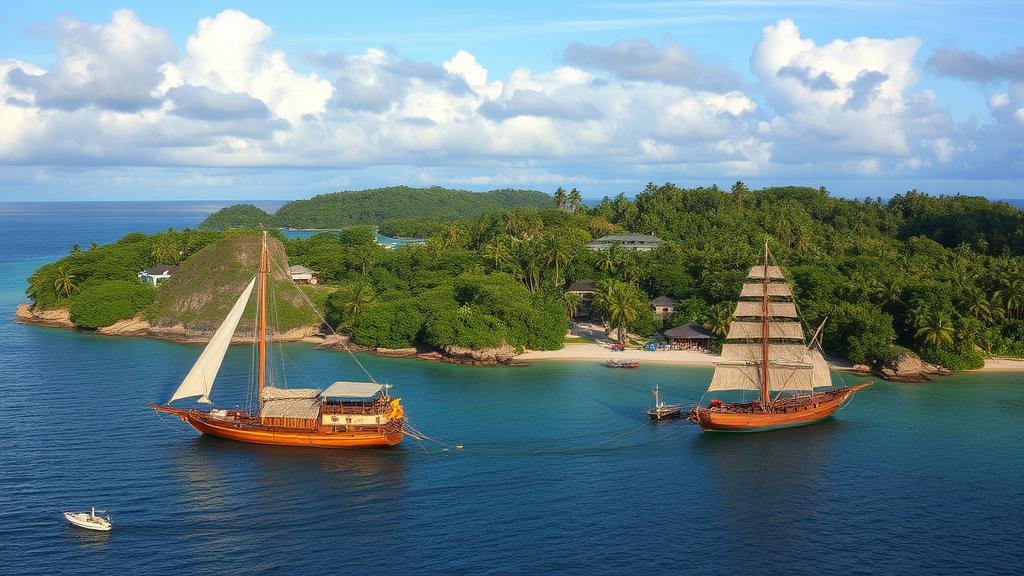Exploring the islands of Micronesia for evidence of ancient maritime trading cities.
Exploring the Islands of Micronesia for Evidence of Ancient Maritime Trading Cities
Micronesia, a region in the central Pacific Ocean, is renowned for its rich cultural history and complex maritime networks. The islands within this archipelago have long been regarded as strategic trading posts, facilitating exchanges among ancient seafarers. This article delves into the evidence of ancient maritime trading cities in Micronesia, highlighting specific locations, historical data, and the profound impact these trading hubs had on the regions development.
A Brief Overview of Micronesia
Micronesia encompasses roughly 2,000 islands across several states, including the Federated States of Micronesia (FSM), Palau, and the Marshall Islands. regions inhabitants developed sophisticated navigational techniques, allowing them to traverse vast oceanic distances. This mastery of the sea not only shaped their culture but also enabled the establishment of significant trading cities.
Historical Context: Ancient Maritime Trade Routes
Maritime trading in Micronesia dates back over 3,000 years. Archaeological evidence suggests that the islands were interconnected through an extensive network of trade routes. By utilizing outrigger canoes and employing celestial navigation, ancient Micronesians effectively facilitated the exchange of goods such as:
- Fish and seafood
- Coconuts and other agricultural products
- Shells for adornments and tools
- Polished stone tools
Key Sites: Evidence of Trading Cities
Nan Madol: The Venice of the Pacific
Located in Pohnpei, FSM, Nan Madol is a remarkable example of an ancient maritime trading city. Comprising nearly 100 man-made islets connected by a network of canals, it served as a ceremonial and political center for the Saudeleur dynasty from approximately 1,500 to 1,800 CE. The site features impressive basalt stone structures, which are thought to have housed the elite class, further indicating its significance in trade and governance.
Recent archaeological excavations have uncovered various artifacts, including pottery and tools, that affirm its role as a trading hub. seamless integration of ocean and land-based resources demonstrates the advanced socio-economic structure of the people who inhabited this region.
Long Island: The Forgotten Jewel
Long Island, part of the Marshall Islands, presents another intriguing case study. Evidence dating back to around 2,000 BCE indicates that the island was used for trading and social gatherings. The discovery of pottery pieces, including decorated bowls and cooking utensils, points to vibrant interactions among neighboring islands.
The strategic location of Long Island allowed it to function as a waypoint for traders, linking the northern and southern groups of the Marshall Islands. Such sites emphasize the interconnectedness of the islands and their people.
The Impact of Ancient Maritime Trade
The significance of ancient maritime trading cities in Micronesia extends beyond mere economic transactions. These cities played a crucial role in:
- Promoting cultural exchange through the movement of ideas, languages, and traditions.
- Establishing political alliances, as traders often negotiated treaties and partnerships.
- Creating a sustainable environment for resource management, notably in fisheries and agriculture.
The wealth generated from trading activities facilitated the construction of impressive architectural sites, further solidifying the social hierarchy within these communities.
Modern Discoveries and Preservation Efforts
Today, archaeologists and historians continue to explore the islands of Micronesia for further evidence of ancient maritime trading activities. With advancements in technology such as ground-penetrating radar and 3D mapping, researchers are uncovering hidden structures and artifacts that provide deeper insights into ancient trade practices.
Preservation efforts are also vital, as many sites face threats from climate change and tourism. Initiatives aimed at conserving sites like Nan Madol emphasize the importance of protecting not just physical structures but also the invaluable cultural heritage they represent.
Actionable Takeaways
For those intrigued by the ancient maritime trading cities of Micronesia, here are some actionable steps:
- Explore further: Plan a visit to archaeological sites, ensuring to engage local guides who can share authentic insights.
- Support preservation: Participate in or donate to organizations dedicated to conserving Micronesian history.
- Educate others: Share knowledge about Micronesia’s rich history and its significance in maritime trade with friends and family.
To wrap up, the islands of Micronesia are not just a tropical paradise but a treasure trove of history that offers profound insights into ancient maritime trading cities. By exploring these sites and understanding their historical context, we can appreciate the intricate web of trade, culture, and politics that shaped this remarkable region.



